#gothic is trending today??
Explore tagged Tumblr posts
Text

Wednesday, December 20.
You there, boy, what day is it (almost)
Why, sir, we are but mere days from the winter solstice, known otherwise as the darkest day of the year. Naturally, you'll find all things gothic trending on Tumblr today. Long may it continue.
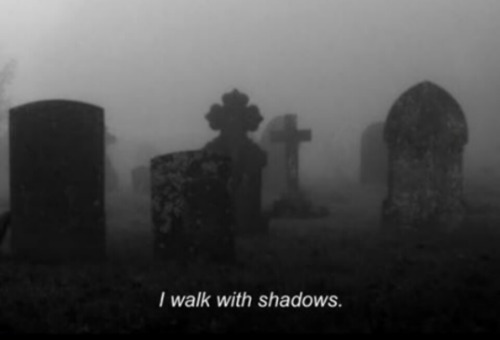
(@blo0delf)
#AHHHH-#gothic is trending today??#goths rule#today on tumblr#gothic#goth aesthetic#yes long shall it continue
734 notes
·
View notes
Text







Dilara Fındıkoğlu Fall 2023
#fashion blog#style#fashion#magazine#fashion trends#fashion tips#street fashion#today on tumblr#art#vogue runway#trending#prada girl#girlblogging#gothic#dilara findikoglu#goth outfit
4 notes
·
View notes
Text

In summer 2022; a 'Vampire-Hunting Kit' said to date back to 19th Century AD, sold at Sotheby's Auction in UK, for more than six times its estimate. Auction house claimed that item had first belonged to Lord Hailey, a man who once served as administrator of British India. It is not known whether man had acquired kit in hope that it would help ward off vampires or simply out of fascination in regard to vampire mythology. Kit included tools such as two matching pistols, a brass flask for gunpowder, a Bible, holy water, a stake, a wooden mallet, rosary beads and crucifixes and it included a locking mechanism to secure contents.
For centuries, vampires have been part of European folklore. In 19th Century AD, there was a trend in regard to purchasing vampire-hunting kits. These constituted expensive novelties intended for people who needed to travel to Eastern Europe, a region where vampires were believed to reside. Kits proved extremely popular in Boston. Still, many scholars explain that most such kits are in fact a mix of authentic objects and artificially aged ones. Even auction houses agree that such items have dubious origins and are not necessarily authentic. However, in past, taking measures against vampires was a very serious thing.
These kits in general are came with the tag of late-Victorian novelties or souvenirs, which sold to tourists travelling to eastern Europe in the wake of the publication of Dracula in 1897. Some sellers and media outlets even claimed that they were made for believers in vampires, for self-defence purposes. But, there is no evidence to support real vampire slayers carting about one of these kits. The fictional stories and movies are the main source of the origin of these vampire killer's toolbox, with their focus upon silver bullets, were very unlikely to have existed prior to about the 1930s at the earliest. Though constructed from antique boxes and contents, they were most likely not produced until the era of the classic Hammer vampire movies. Other kits are harder to pin down in terms of date and could be older, but there is as yet no evidence of this. Scholars considered that they are 'hyperreal' or invented artefacts somewhat akin to stage, screen or magician's props. They can also be regarded, and indeed have been sold as, pieces of modern art. Formerly the preserve of art galleries and of course libraries, contemporary collection is now also a staple of museum collecting policies. These enigmatic objects still transcend questions of authenticity. They are part of the material culture of the gothic; aspects of our shared literary and cinematic passions made physical. Lacking any surviving artefact of vampirism either folkloric or fictional, fans of the gothic had created one to fill the gap.
Historically, archaeologists have uncovered shackled bones of a woman once believed to have been a vampire. Woman buried in a 17th Century AD, Polish grave had a sickle blade positioned across her neck meant to decapitate her in case she attempted to rise from her grave as a vampire. Woman also had a padlock on her toe symbolizing "closing of a stage and impossibility of returning" as the professor leading excavations had explained. Woman had a pointy front tooth which led to suspicions of vampirism on part of her contemporaries, so specifics of her burial illustrated vampire-related superstitions.
Today, museums do collect deliberate fakes as comparators and for their own artistic and cultural merit, yet vampire kits are not fakes per se, because there is no evidence of a Victorian original. Self-defence against supernatural was for many in history (and indeed today) a matter of life and death, but the weapons they used were ephemeral. The wooden stakes, guns, and agricultural implements that they attacked vampires and other revenants with either no longer survive, or have lost their provenance and are unable to tell us their story.
#dark academia#dark aesthetic#vampire#halloween#artists on tumblr#gothic#dark core gothique#horror lover#goth aesthetic#vampire pictures#vampire hunter#vampire hunter oc#vampire hunter x vampire
20 notes
·
View notes
Text
amaretto
Miguel/Reader | Explicit | Chapter 1/?
a/n: I brought this blog back from the dead to post this so I hope y’all enjoy. Gonna be a few chapters but not sure how many yet. Femdom reader, Bartender Miguel basically. Horny and angsty modern NYC AU, no powers. Bit of a slow burn (ish). Enjoy lol
***
The Basilica is, for all intents and purposes, a mediocre bar.
There’s a pothole steps away from the bar’s entrance that customers have to maneuver past in kitten heels and designer sneakers, and the embossed metal sign at the front of the door is almost completely covered in rust. It’s clearly an establishment that’s too pretentious to be a dive bar, but not exactly up to code enough to be an upscale cocktail bar either.
Recent attempts to rebrand the place as a hole-in-the-wall speakeasy have been successful, meaning that it’s now the common haunt for every art history graduate student, Bauhaus enthusiast, and unattainably gorgeous bisexual poet in lower Manhattan who’s willing to spend 17 dollars on a drink.
You stumble across the small chipped navy blue door after a brutal day at work. The patrons at the luxury handbag store you have the distinct displeasure of interacting with were particularly snippy today, and your pair of not-yet-broken-in oxfords feel more like a prison than a fashion statement at the moment. You need a drink to help forget the past ten hours ever happened just so you can do it all over again tomorrow. You’ve never heard of this place, but you don’t feel like getting on the subway just yet and looking for a bar that’s closer to home. This vaguely sketchy place will have to do.
The cozy interior of The Basicilia smells of cigar smoke and melting wax. Lit partially by candlelight, the brick walls and small antique cherrywood tables feel distant, yet homey. There are large gothic-style lanterns hanging from the low ceiling, and servers expertly move through the crowd carrying stainless steel trays full of thick-cut fries and bowls of green olives.
Despite the bar being relatively full, only one other person is sitting at the actual bar when you approach it—everyone else appears to be relegated to the various tables and benches strewn about the space, or hugging the walls holding glasses of craft beer.
With all of the fuss that sitting down on a stool, pulling off your winter coat, and hanging your things on a hook underneath the bar causes, it takes you a moment for you to see him.
But you do.
There’s a blur of movement in the corner of your vision as a tall man in a black button-down with rolled-up sleeves vaults over the bar wall and stalks over to the other end of the restaurant before knocking on a solid black door with the sole of his boot.
“Hey! You awake in there? They need help running food!” The man shouts, not waiting for a response before rushing back across the room and climbing back into the bar.
The sound draws a few eyes, but no one appears to be shocked—it seems to be a common occurrence here, judging by the way the person who appears to be the manager steps out of the previously kicked door looking bleary-eyed and sheepish, a pair of noise-canceling headphones around his neck and a set of keys jangling at his belt.
But your attention has been drawn elsewhere.
The man is tall enough to reach for a bottle of Belvedere vodka on the top shelf to hand to a nearby barback without straining. You notice his hands first—broad, veiny, with nails cut down to the bone. There’s a bandage wrapped around the middle finger on his left hand. A smattering of hair on his triceps, which are all muscle and sinew. And two tattoos—-a fang on his right bicep, and a bundle of marigolds on his left forearm. He leans onto the bar table to address you, his button-down snug around his chest.
Jesus fucking christ. If you had a drink you would certainly spill it.
“What are you getting,” he says—his voice raw from shouting, you assume—and his voice trends downward at the end of the sentence, as if he doesn’t want to ask you, as if it isn’t a question. You can’t even pretend to be offended—working in the service industry is a thankless task, and you know that well enough. But even you can admit that the level of tension in his jaw and the shuttered look in his eyes is disconcerting in a way that has to do with more than the fact that he presumably hates his job.
“A mojito, please,” you say, with less confidence than you’d normally have. You’re used to sitting at bars alone and making conversation with the bartenders, but tonight doesn’t seem to be going in that direction.
“A mojito?” The man repeats, and you know it’s the wrong choice somehow. Other than an almost imperceptible eye roll, he nods, turning his back to you to grab the right ingredients.
Still. It makes you curious.
“What’s wrong with a mojito?” you ask, watching the way his shoulders stiffen. It’s like his entire being is on constant guard, waiting for the other shoe to drop–you can see it in the way he turns back to look at you, his jaw set as he sets down a collins glass and starts picking damp mint sprigs out of a chilled metal container.
“First time here?” he says, and again, it isn’t a question. He places the mint leaves on a paper towel to dry before rubbing them on the rim of the collins glass and putting them in a separate pint glass.
“Yeah. What’s wrong with a mojito?” Normally you’d take your cue from the bartender and quit trying to make conversation, but something about him makes you want to poke and meddle, like touching a live wire with the tip of your finger.
“Nothing.”
“I won’t get offended. Is this one of those ‘what your drink of choice says about you’ things?” you probe, leaning onto the bar top. The other conversations seem to fade to a lull in the background of your mind, your sights set on tormented brown eyes and tense, broad shoulders.
“No.”
“Because that kind of seems like what this is—”
“No.”
“Then what is it? If you don’t mind me asking. I hope I’m not committing a major bar crime, or something.” He clearly minds, and the sigh he lets out is nothing short of torturous sounding, but he seems to indulge you anyway. You briefly register his hands reaching for various cups and bottles at an even tempo, his movements intentional as he makes your cocktail. He crushes mint and lime and sugar together with a blunt tool before opening a carafe of ice. A shiver runs through you, completely against your will, as you watch him work. You’ve always had a soft spot for competence.
“It’s more of a practical thing,” he explains, and you settle onto your stool, sensing a tangent incoming. “Mojitos aren’t complicated to make, but they take time. They have a lot of moving parts. And then once one person orders it, I get ten more people who saw me making it asking for it too, and I have to start the process over again. And then more people order it, and next thing you know I’m making mojitos for the rest of the night.”
“So when I ask for mojitos at other bars and they say they’re out of mint, are they lying?” you tease. He places your drink in front of you then, topping it off with a mint spring and a lime wedge at the rim of the glass.
“...Every bartender hates you,” he says in response, leaning in, and you give him a soft smile, sipping from the glass. It’s one of the best drinks you’ve ever had.
There isn’t an ounce of enjoyment to be seen in his eyes, or in the shadows of his face. But you swear you see a flicker of something there, like something that has long since lain dormant coming back to life—if only for a second–before it dissipates.
“What’s your name?” you ask, pushing your luck. Any spark that had once been lit is extinguished. He backs away, the lanterns from overhead casting shadows across his features that make him look like a stranger again. You silently curse yourself.
“I don’t do that,” he shakes his head, before venturing to the other end of the bar to help a seemingly new bartender whip up a martini. You wait patiently, watching the way his mouth moves and his hands gesture as he corrects the bartender on their…technique, or something. You have no idea. From afar, he looks equally as intimidating, if not more so. The lines of his body don’t indicate any kind of softness, and his shoulders are slightly hunched as if he’s ashamed of himself. You wonder if he does bicep curls in a concrete room for hours until he sweats out all of the vulnerability. Or maybe he runs from it, in the early morning, breath labored and lungs aching until his sneakers are worn out.
“You don’t do names?” you ask him as soon as he returns, and his time he doesn’t even pretend to hide his exasperation, rolling his eyes again before resting his elbows on the bar so that his face is inches away from yours. Your heart lurches. A quick glance around rewards you with a few of the patrons regarding you with a vague amount of interest—and concern.
“Listen. I’m not a therapy session bartender,” he says with enough disdain to cause your eyebrows to raise in surprise. “I like the theory of it. The drink making. That’s it. Talk to that guy,” he continues, gesturing to a fellow bartender with a man bun and gauges who’s currently chatting up the only other person sitting on the other end of the bar. “He’s chatty.”
This close-up, you can see the dark circles around his eyes, his slightly chapped lips. You get a brief urge to trace the wrinkles across his forehead with the pads of your fingertips, but you hold off, of course. The man seems like he’s too old for anyone. He’s lived a million lifetimes.
“I don’t want to talk to that guy,” you say, feeling emboldened. I want to talk to you. “No offense.”
Something in his expression flickers back to life once more, like a butterfly trying to fly without one of its wings.
“Miguel,” he says after a while, sounding pained. You tell him your name, and he gives no indication that he’s registered it.
“Do you wanna open a tab, or close it?” Miguel asks then, and his voice sounds weightier.
“...Keep it open.”
***
The bar is sweltering, but the cold, sour tang of the mojito keeps you cool as you watch Miguel make his way across the bar to help mix drinks for other patrons. You feel pinned to your stool somehow, like a bug under a microscope, even though Miguel doesn’t spare another glance in your direction. The music in here is alright, but not noteworthy. You wish you had someone to dance with.
The bartender with the man bun makes you another mojito before you can say otherwise, but it tastes different somehow. Too much mint maybe. Not enough bitterness. Miguel’s theory seems to be wrong; you scan the bar for other tall glasses with sprigs of bright green mint and find none. After brief consideration, you decide not to bother him any further by informing him of this fact.
The bar gets increasingly more crowded as the night goes on, and it becomes abundantly clear that Miguel isn’t going to check on you again. You want to believe it’s because he’s too busy, but you wonder if you made the wrong impression somehow. You wonder why you care. You hate that you do.
You settle your tab and gather your things before buttoning your coat and setting off into the night. Your two drinks have muddled your senses just so, but not enough to be completely disorienting. On the precipice of happy, maybe.
As you zip your coat up to your chin and walk down the sidewalk, you think about going home to your studio apartment and cuddling with your cat Cinnamon. You think about hopefully getting a few hours of sleep before the workday comes back around in the morning to swallow you whole once again. You think about the harsh line of Miguel’s jaw, about the fact that he’ll likely forget about you come morning.
“Every bartender hates me,” you repeat to yourself—a truly harrowing fact—before shaking your head and walking down the steps into the subway.
a/n: lmk if you enjoyed/if you wanna see more—mwah x
#dom reader#miguel o'hara#miguel x reader#miguel x y/n#miguel x you#miguel spiderverse#miguel spiderman#miguel smut#miguel 2099#atsv miguel#atsv x reader#atsv fanfiction#atsv fic#atsv fandom#across the spid#sub miguel o'hara
61 notes
·
View notes
Note
Hello! My play group has recently begun a PF2e game and we're enjoying it, but as an almost-forever-GM running one-shots looking for The Next Big Game to run I'm definitely noticing a trend of "a small run of bad rolls has decided you lose" that stands in contrast to a more subjectively "forgiving" system like Cypher or Quest. I know any dice-based game can theoretically end up with the dice deciding "you lose tonight," but it got me to thinking about that feeling in trying new systems. We definitely love mechanics in play - i.e. I'm not strictly looking for diceless systems, but they're not off the table either - so I'd love to hear about games you like and think are on the forgiving side of the spectrum with regards to bad luck streaks. Thank you!
THEME: “Forgiving” Games.
Hello friend, I love these kinds of games a lot. Here's a few outside of Numenera, which you already seem to know about. I tried to stick with games that have some longevity, although I'm not sure how long you can play Our Haunt as a campaign.
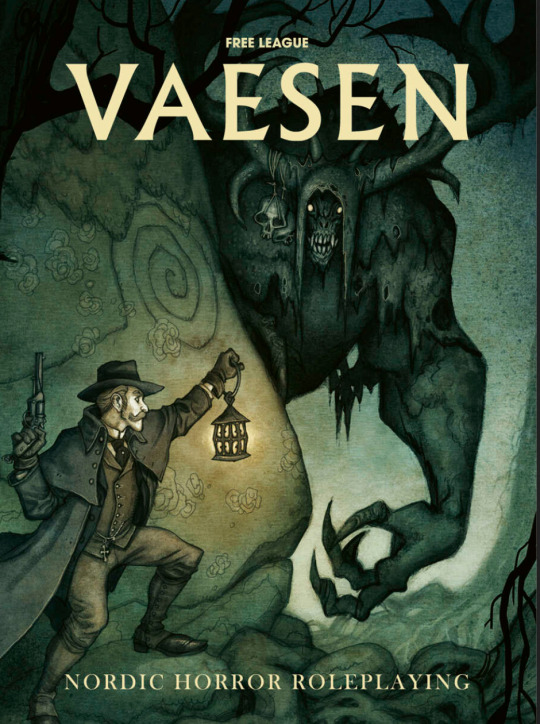

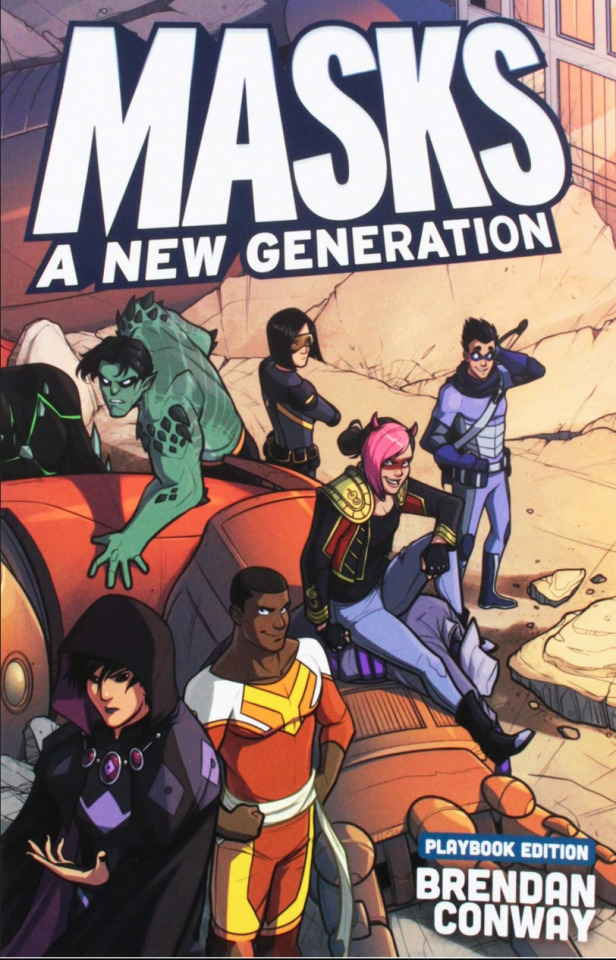

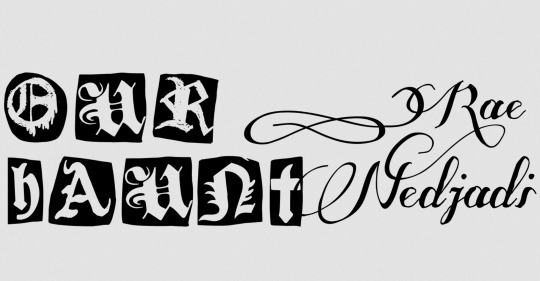
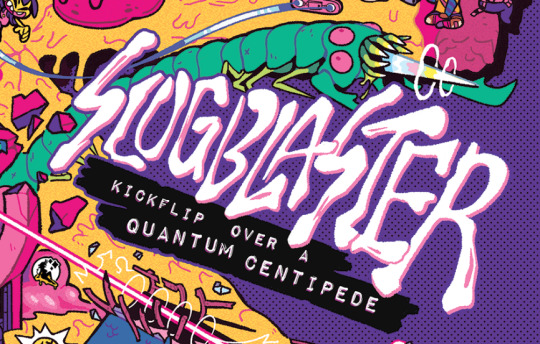
Vaesen, by Free League Publishing.
Welcome to the Mythic North – northern Europe of the nineteenth century, but not as we know it today. A land where the myths are real. A cold reach covered by vast forests, its few cities lonely beacons of industry and enlightenment – a new civilization dawning. But in the countryside, the old ways still hold sway. There, people know what lurks in the dark. They know to fear it.
Vaesen – Nordic Horror Roleplaying is written by Nils Hintze and based on the work of Swedish illustrator and author Johan Egerkrans. Vaesen presents a dark Gothic setting steeped in Nordic folklore and the old myths of Scandinavia. The game mechanics utilize an adapted version of the award-winning Year Zero Engine.
Vaesen allows players to do something called pushing the roll, although you can only do it once per any given action. You will roll a number of six-sided dice according to a skill + attribute combination, and aim to roll 6’s, which are successes. Pushing the roll allows you to re-roll any dice that did not come up as a 6, thus giving you a second chance - or a chance to be more effective, if you need more than one 6 to do what you want to do.
Since Vaesen is a horror game, however, this push doesn’t come without a cost. Choosing to Push a roll means that your character will have to take on a condition, which is represented as either a Physical or Mental injury or affliction. Take too many in the same category, and your character becomes Broken, thus requiring immediate medical attention. Conditions can be healed and cured, so how deadly your game is depends on how little (or much) rest time your characters have in between encounters.
Genesys, by Edge Studio.
Face down a dragon as a brave knight, hack into a corporate security system as an elite runner, set sail in your airship. Unlimited adventure awaits you in Genesys, a new roleplaying system designed for a variety of settings and limited only by your imagination.
The Genesys experience begins with the Genesys Core Rulebook, which features an explanation of the innovative narrative dice system and core mechanics of the game, an overview of five different settings in which to place campaigns, and advice for Game Masters to craft a myriad of adventures with unparalleled freedom.
So I’d really like to recommend the Star Wars RPG that spearheaded this system, but as far as I understand it’s getting harder and harder to get a hold of. The core system, however, is still available on DriveThruRPG, and I really like how it handles dice rolls. The Genesys system uses a custom set of dice that have three different levels of results: advantage/threat, success/failure, and triumph/despair. These symbols typically cancel each-other out. Both positive and negative dice have a number of different symbols on their faces, and rolling more successes for example, means you’re not going to have less advantages, while rolling a higher number of threats will lead to less failures.
This means that the two most common rolls you will get will be Success with a Threat and Failure with an Advantage. Therefore each roll has both a positive and negative result. If you end up rolling extra-special dice, you might end up with a Triumph and/or a Despair, which happen regardless of any other rolls. So you could have a Failure with an Advantage and a Triumph - which might mean that maybe you don’t unlock that door, but maybe you hear someone coming and duck into a hidey-hole before they show up - and they turn out to be an ally.
Genesys is a toolkit that you can use to make your own game, but if you want a setting to go with it, you might want to check out Realms of Terrinoth (Fantasy), Keyforge: Secrets of the Crucible (gonzo sci-fantasy), or Shadow of the Beanstalk (cyberpunk).
Masks: A New Generation, by Magpie Games.
Halcyon City has had more than its fair share of superheroes, superteams, supervillains, and everything in between. Your team of young supers must forge your own path amidst the pressures of a world full of people telling you what to do and who to be, and kick some butt along the way!
Masks: A New Generation is a superhero tabletop roleplaying game full of action, youthful angst, and dazzling bravery. Take on the roles of members of the latest generation of superheroes, young adults trying to figure out who they are and what kind of heroes they want to be.
MASKS is well-known and for a good reason. It’s an excellent introduction to the PbtA framework, and contains a lot of solid advice for the person who’s running the game. One of the core pieces of advice that you can take from this game to others in the same system-family is that of Soft and Hard moves. When a PC rolls a 6 or less, the ball is in your court, but as the GM, it’s up to you how bad the character fails. Soft and Hard moves are a key part of this.
While a straight-up failure may be needed once in a while, sometimes all you need to do is telegraph danger, and give your players another chance to try a different approach. This is called a Soft Move. You might place the characters in an eerie atmosphere but give them a chance to act, or present them with an NPC asking difficult questions, but give them space to answer. You might not even require them to roll at all - if you think that the hero should be able to do something, they’ll do it.
Finally, since Masks is about teenage superheroes, death isn’t really on the table. What’s at stake is their self-image, and that is reflected in the emotional damage the characters take. This chance to wrestle with why they truly are might even be something welcome for the players to dig into - I know me and my friends sometimes found moments of interpersonal conflict to be the most rewarding.
Endeavour, by Armiger Games.
You are an officer aboard the Interstellar Confederation Ship Endeavour. Your mission is to explore the galaxy. You will travel deep into uncharted space where you will encounter strange phenomena, make first contact with alien civilizations, and help those in need.
This is an optimistic-science fiction game. It is a game about a future in which humanity has progressed beyond the kinds of internecine conflicts that plague modern society. Advanced technology is common and has created a post-scarcity society throughout the Interstellar Confederation.
Stories in Endeavour generally involve some kind of moral quandary. Moreover, the futuristic setting acts as lens through which we can view contemporary social issues. The best such stories are fundamentally about the difficult choices the crew are asked to make and how they are affected by their experiences.
Endeavour is a play-set for AGON, a game about Greek Heroes setting out to make a name for themselves. You need AGON to play, but the rules for both these games take a very unique approach to solving problems.
Almost every conflict present in Endeavour is a collaborative Challenge. This means that any time an obstacle presents itself, the group has a chance to face it as a team. Facing Challenges as a team increases chances of success in two ways: in one way, since each player might be participating, there is a higher chance that one person or another rolls a high enough number to pass the challenge. However, players can also choose to aid each-other, foregoing a chance to gain Distinction but improving another player’s chance at success.
Our Haunt, by Rae Nedjadi.
We are ghosts. We are in a house we don't recognize. We have a handful of memories, and these memories are brief moments and flashes of barely something. The Living are nearby, and they encroach on our space, making their demands. Worse, there is a Thing in the Walls. It is ancient, inhuman. Hungry, yearning. Angry.
But this is Our Haunt now. This is our home, and we only have each other as family. If we take care of each other, good things will happen. We just know it.
Our Haunt uses a diceless system called Belonging Outside Belonging, or No Dice, No Masters. This can be GM-less, but it doesn’t have to be - and I definitely recommend checking other games that use this system if you want to control the level of failure.
BoB games use a token-based economy, where following certain prompts on your character sheet will give your character the ability to use other abilities listed on their character sheet. This creates a rhythm, between moves that invite interesting interactions or complications, and moves that push the story forward, or allow you to do something special.
Each playbook usually also has special moves that the character can do for free, that neither earn nor spend a token. Because the use of tokens is up to the players, failure will only happen when you decide it happens, and every failure banks a potential success, so even if Our Haunt isn’t what you’re looking for tone-wise, I definitely recommend checking out other Belonging outside Belonging games.
Slugblaster, by Wilkie’s Candy Lab.
In the small town of Hillview, teenage hoverboarders sneak into other dimensions to explore, film tricks, go viral, and get away from the problems at home. It’s dangerous. It’s stupid. It’s got parent groups in a panic. And it’s the coolest thing ever.
This is Slugblaster. A table-top rpg about teenagehood, giant bugs, circuit-bent rayguns, and trying to be cool.
Forged in the Dark games allow you to succeed at least partially on a result of a 4 or higher, so you’re much more likely to succeed with a cost than straight up fail, and even if you do take some kind of consequence, that consequence can always be thrown off by using something called a Resistance Roll. The original system, Blades in the Dark, still felt pretty brutal if you played it as written. However, Mikey Hamm, the designer for Slugblaster, wanted to make a game about teenagers hoverboarding across dimensions, not hardened criminals surviving in a brutal city, so he made some key changes.
Kids in Slugblaster may take “slams”, but no damage is permanent. Staying in another dimension too long may trigger an unpleasant experience called peelback, but it doesn’t kill you, and if you log a bunch of doom (the game’s Stress equivalent), you don’t take a permanent condition - you worry your folks, or have to spend your extra free time doing homework. At its core, Slugblaster’s biggest threat is losing your status - you’re not really in physical danger.
Other Games to Check Out
Wanderhome, by Jay Dragon.
Spectaculars, by Scratchpad Publishing.
53 notes
·
View notes
Text






I am posting some Madeline Smith today because I rewatched the Vampire Lovers last night. It's a movie I have always held near and dear to my heart since I was just a little kid and watched it and was pretty sure it's about as erotic as a movie can get. Usually that leads to me posting Ingrid Pitt, who is the titular Vampire but it's a Hammer movie from the 70's and Hammer Glamour means all the girls are kind of titular if you get my drift. Anyway, I adore the old Hammer stuff and I am not going to claim everyone needs to rush out and see any of it but there's a reason its the stuff that has stood the test of time. If you don't know, Lesbian vampires were a huge, huge cinema trend in the 70's but it's the Hammer Karnstein trilogy that has maintained it's place in the world of horror while most of the rest have fallen away (you can make an argument for Vampiros Lesbos but that is really something only mega nerds know, so you've just outted yourself as a mega nerd if you were thinking of that). I would say @kat-eleven could give you her opinion as she watched the movie but her opinion was wrong, full of takes like, "Why are those girls kissing" and "I feel bad for the boys who won't get to have a wife now cause the girls are all kissing each other". To each their own I guess. Madeline Smith was in quite a few Hammer movies over the years and looked great in all of them. I have actually posted her twice before but I bet it's been since 2016 or so I did the last time. She has very big eyes which are good at conveying a doe eyed sort of innocence that works for Gothic Horror. She has to be innocent and naive for some of it to work. She also has big other things which is important when fulfilling Hammer Glamour, the term applied to Hammer's use of period dress that was rather low cut. But classy cause it was olden days. A sophisticants cleavage if you will. Anyway, here is Madeline Smith with all her big eyes and sophisticated cleaveage. Today I want to fuck Madeline Smith.
27 notes
·
View notes
Text
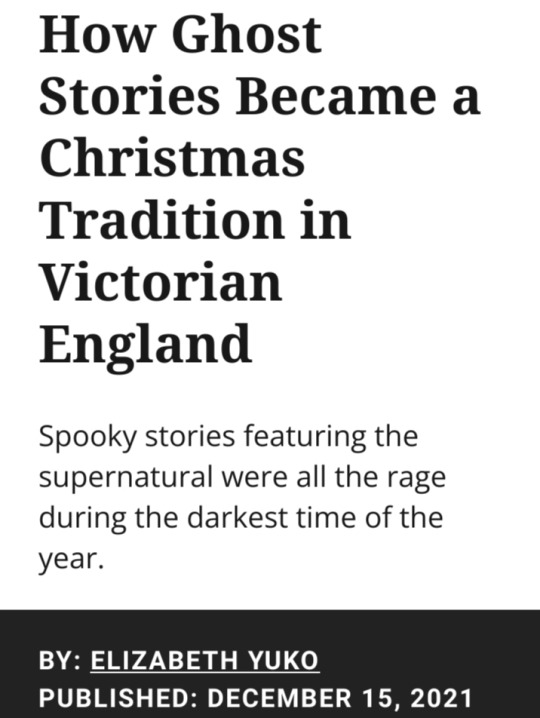
Towards the end of each year, as fireplaces are lit and hot cocoa is made, Americans have made it a tradition to revisit their favorite classic holiday books, movies and songs.
And though ghost stories may seem out of place in present-day American holiday celebrations, they were once a Christmas staple, reaching their peak of popularity in Victorian England.
A Dark, Spooky Time of Year
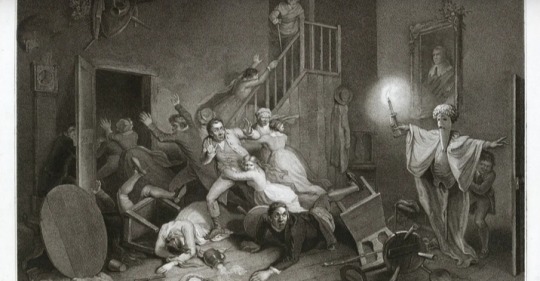
Like most longstanding cultural customs, the precise origin of telling ghost stories at the end of the year is unknown, largely because it began as an oral tradition without written records.
But, according to Sara Cleto, a folklorist specializing in British literature and co-founder of The Carterhaugh School of Folklore and the Fantastic, the season around winter solstice, has been one of transition and change.
“For a very, very, very long time, [the season] has provoked oral stories about spooky things in many different countries and cultures all over the world,” she says.
Furthermore, spooky storytelling gave people something to do during the long, dark evenings before electricity.
“The long midwinter nights meant folks had to stop working early, and they spent their leisure hours huddled close to the fire,” says Tara Moore, an assistant professor of English at Elizabethtown College, author of 'Victorian Christmas in Print' and editor of The Valancourt Book of Victorian Christmas Ghost Stories.
“Plus, you didn’t need to be literate to retell the local ghost story.”
Effects of the Industrialization Revolution

It was in Victorian England that telling supernatural tales at the end of the year — specifically, during the Christmas season — went from an oral tradition to a timely trend.
This was in part due to the development of the steam-powered printing press during the Industrial Revolution that made the written word more widely available.
This gave Victorians the opportunity to commercialize and commodify existing oral ghost stories, turning them into a version they could sell.
“Higher literacy rates, cheaper printing costs, and more periodicals meant that editors needed to fill pages,” Moore says.
“Around Christmas time, they figured they could convert the old storytelling tradition to a printed version.”
People who moved out of their towns and villages and into larger cities still wanted access to the supernatural sagas they heard around the fireplace growing up.
“Fortunately, Victorian authors like Elizabeth Gaskell, Margaret Oliphant, and Arthur Conan Doyle worked through the fall to cook up these stories and have them ready to print in time for Christmas,” Moore says.
Industrialization not only provided tools to distribute spooky stories, uncertainty during the era also fueled interest in the genre, says Brittany Warman, a folklorist specializing in Gothic literature and co-founder of The Carterhaugh School of Folklore and the Fantastic. She adds:
"Interest was driven by the rise of industrialization, the rise of science, and the looming fall of Victorian Britain as a superpower.
All of these things were in people's minds and made the world seem a little bit darker [and] a little bit scarier.”
Stories Find a Wide-Ranging Audience
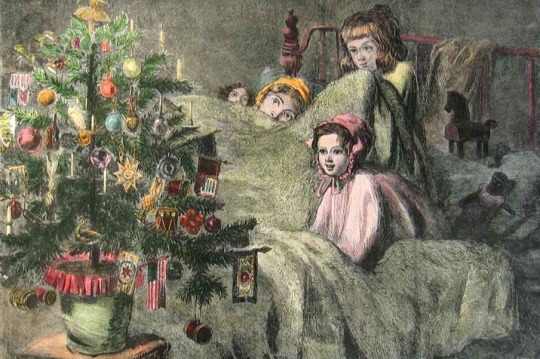
Telling horror-filled holiday tales continued to be a family affair in England, even when they were read rather than recited.
“We know from illustrations and diaries that whole families read these periodicals together,” Moore says.
The popularity of Victorian Christmas ghost stories also transcended socioeconomic status, according to Moore.
They were available to read everywhere from cheap publications to expensive Christmas annuals that middle-class ladies would show off on their coffee tables.
Their broad audience was reflected in the stories themselves, which sometimes centered around working class characters and other times took place in haunted manor houses.
“These upper class settings were intended to invite readers from all classes into an idealized, upper-crust Christmas, the type todays’ fans of Downton Abbey still enjoy as entertainment,” Moore adds.
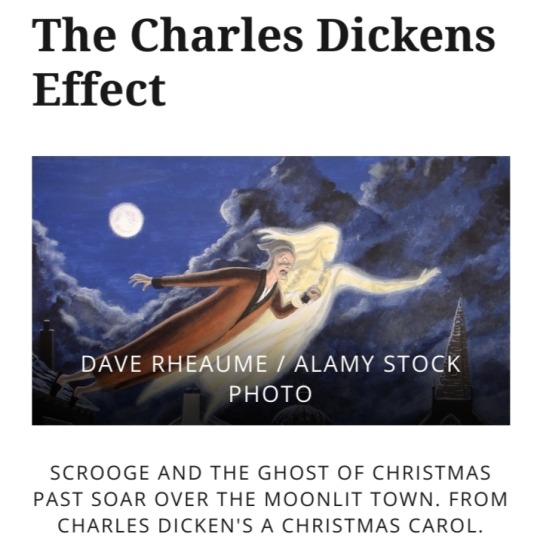
Charles Dickens’ 1843 novella A Christmas Carol has forever linked the British author with the holiday season, but his contributions to Christmas in Victorian England — including the tradition of telling and reading ghost stories — extend far beyond Jacob Marley’s visit to Scrooge.
In fact, Cleto says that Dickens played a “huge part” in popularizing the genre in England.
“He wrote a bunch of different Christmas novellas, several of which involved ghosts, specifically,” she says, “and then he started editing more and more Christmas ghost stories from other people, and working those into the magazines he was already editing. And that just caught like wildfire.”
Dickens also helped shape Christmas literature in general, Moore says, by formalizing expectations about themes like forgiveness and reunion during the holiday season.
American Christmas Traditions: More Syrupy Than Spooky
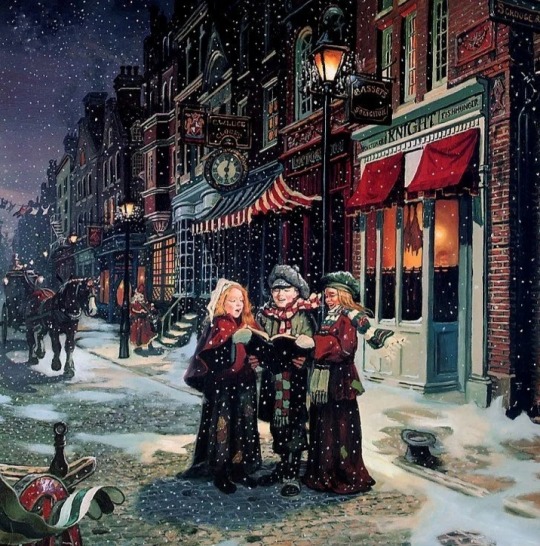
Although countless trends made their way from England to America during the Victorian era, the telling of ghost stories during the Christmas season was not one that really caught on.
A Christmas Carol was an immediate best-seller in the United States, but at the time of its publication, Dickens was arguably the most famous writer in the world and already wildly popular.
The novella’s success in the U.S. likely had more to do with Dickens’ existing (massive) fan base than it did Americans’ interest in incorporating the supernatural into Christmas.
“American Christmas scenes and stories tended to be syrupy sweet,” Moore explains.
"There were a few American writers of the period trying to put Victorian-style Christmas ghost stories into American culture,” Warman says, including Nathaniel Hawthorne and Henry James.
Washington Irving made a similar and earlier attempt, slipping the supernatural into Christmas-themed short stories published in 1819 and 1820.
Warman theorizes that America’s reluctance to embrace the Christmas ghost story tradition had to do, at least in part, with the country’s attitudes towards things like magic and superstitions.
“In America, we generally had a bit of a resistance to the supernatural in a way that European countries didn't,” she explains.
“When you come to America, you come with a fresh start. You come with a secular mindset and the idea that you were leaving the past behind. And some of these spooky superstitions were thought of as being part of the past.”
Another reason telling spooky stories never took off as a Christmas tradition in the United States was because it became more firmly established as a Halloween tradition, thanks to Irish and Scottish immigrants.
“That really impacted culture here, because they brought with them a concept similar to Halloween and that became, for America, the time period for ghosts,” Warman explains.
Traces of the Tradition
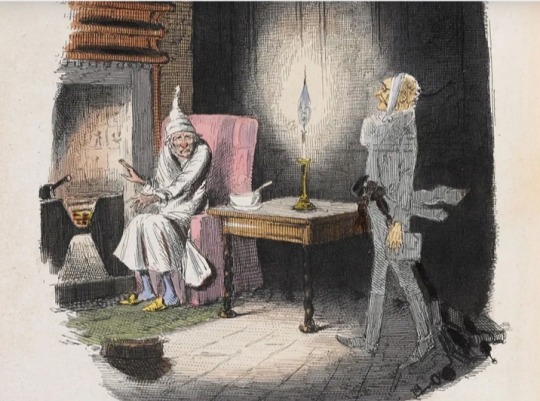
Other than A Christmas Carol, there is another piece of pop culture that reflects the Victorian Christmas tradition: a single line from a song written and released in 1963 by American musicians.
First recorded by Andy Williams, the song “It’s the Most Wonderful Time of the Year” lists 'scary ghost stories' as one of the highlights of the holiday season.
Although it’s unclear why the writers of the song (Edward Pola and George Wyle) included the tradition, Cleto says that it’s possible that the lyric is a reference to Dickens’ A Christmas Carol.
“It's only the one text,” she notes, “but it's such a big deal here in the US and the UK, and is pretty much all that Americans know about Christmas ghost stories in isolation.”
#Christmas#Christmas Ghost Stories#Victorian Era#1800s#19th century#Victorian England#oral tradition#written records#Sara Cleto#winter solstice#folklore#British literature#spooky storytelling#Tara Moore#steam-powered printing press#Industrial Revolution#ghost stories#Brittany Warman#Victorian Christmas#Charles Dickens#A Christmas Carol#Jacob Marley#Scrooge#Halloween
35 notes
·
View notes
Note
Random Concept: Terry Silver with a TikTok-obsessed Beloved
It would be cute if beloved wanted to film cute couple moments with Terry.
Spicier with Terry during the Halloween season because of all the Ghostface masks trending.
I can imagine Gen Z beloved doing something like the Gothic Baby account if they have a kids with Terry.
Like, I do think Terry Silver, in his old age majorly keeps up with trends.
He always has.
He always had his finger on the pulse of the 'brand new thing'.
More so than young people, undoubtedly --- he's a businessman, after all.
He's too clever not to keep up. That's how he can blend in so perfectly and adapt if need be, being chameleonic in nature, changing and transforming with the times. It's how he can manipulate perceptions and cultural norms --- by being in touch with things around him, sure, like the advent of social media. The Online sphere. Being Vegan for a while, because that's a la mode and acceptable in a more Liberal, upper crust crowd in Los Angeles --- it's admirable, even. A societal badge that says one's a conscientious, good person (And Terry Silver's just that? Right?) when that wouldn't have been the case in the past. Thirty years ago it was perhaps the discourse between nuclear and fossil fuels or green new energy that mattered, and today, it's all about Tik Tok. It's Twitter. Or X, rather. And what's trending on there --- the type of stuff that can make or break one's reputation because someone said something stupid or cancel-worthy two decades ago. Heck, even the branding of social media itself changes, having one name and taking on another practically overnight! The world moves fast and Terry Silver moves with it. But, in spite of him been keenly aware what's what and what it means, I envision his Online presence is incredibly scarce and unbelievably curated on purpose and what information can be found on him on the Internet has been fine combed and is continuously fine combed so really, not only can you not find anything too controversial about him on there (maybe just the right amount of controversial, tactically speaking; acceptable controversies, as to not make him seem too inhumanly saintly and by extension, unrealistic, too suspicious and fake) --- you can't even really find anything much of anything in general except what Terry deliberately and specifically wants on there. Man's incredibly private all while putting up a facade that he's an open book --- which, don't be fooled, he's anything but.
What I mean to say with this is that Terry Silver undoubtedly wouldn't be on Twitter, for example, posting his actual, real opinions about...anything. He's smart like that.
So, any beloved of his? Gen Z or otherwise?
Chances are, they wouldn't be chronically Online either.
They wouldn't be on Tik Tok, plastering videos of themselves, their family or Terry Silver himself for the world to see consistently, because the thought of thousands of people (Voyeurs, the way an already voyeuristic Terry would see it) tuning in to see and watch his beloved --- random punks commenting on them, expressing their opinions willy-nilly, judge, complementing them, leering, passing, bookmarking, downloading and sharing said clips around unstoppably, without any monitoring as to how they could use and abuse such material...legitimately forever --- well, it presses the button of someone fiercely territorial, jealous, possessive, protective and control oriented like Terry. He doesn't like it. He doesn't allow it. He thinks it's bullshit. He would take advantage of someone's else's uploads Online for sure, if push ever came to shove, so maybe it is a bit of projection on his behalf, that somehow, someone, somewhere, would do the same to him and someone who belongs to him to weaken him or retaliate against him, so to take precaution against it, beloved's presence Online becomes, possibly, even scarcer than his, because they're the most precious thing he has and when something or someone's precious or valuable, they're tucked away. Hidden, in ways. Plus side to this, though --- I can envision Terry Silver, like a man who was young in the 70's and 80's being big on home videos instead. Private collections for his private viewing pleasure and usage only. Cute couple moments galore are permissible --- everything is permissible, in fact --- but these recordings, lets call them, belong and remain explicitly in Terry Silver's private care, because he's a man who doesn't wear his heart on his sleeve and tends to strategically tuck away everything that ever mattered to him. Everything that makes him vulnerable. Everything that can compromise or damage him. Most of everything he really is from the public. Includes beloved. Whatever children he might or might not have with them.
If someone was somehow skillful enough to discover their names and Google them, chances are, nothing specific comes up in their search results. Not anywhere.
That's deliberate.
#would be hilarious if someone tried to look up terry silver's beloved and several of his ex conquests come up instead#you know...as a way to distract and kill the trail from the one he really loves being in the search engine's spotlight#terry silver#kk3#cobra kai#the internet#technology#social media#tik tok#gen z culture#tw; generational gap#terry silver x reader#terry silver x beloved#halloween
30 notes
·
View notes
Text
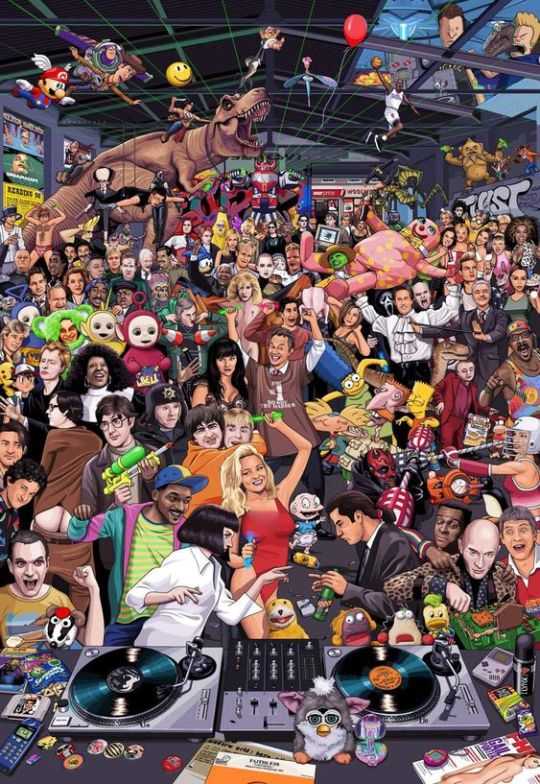
The 1990s was a pivotal decade for geek culture, solidifying many of the trends and franchises that continue to influence pop culture today. Here's an exploration of the various facets of geekdom in the 90s:
Video Games
The 1990s were a golden era for video games, seeing the rise of iconic franchises and gaming consoles.
Consoles and Games:
Super Nintendo Entertainment System (SNES) and Sega Genesis were at the forefront of the early 90s gaming scene. Classics like "The Legend of Zelda: A Link to the Past," "Super Mario World," and "Sonic the Hedgehog" became household names.
The mid-90s introduced the Sony PlayStation and the Nintendo 64. Games like "Final Fantasy VII," "Metal Gear Solid," "Super Mario 64," and "The Legend of Zelda: Ocarina of Time" revolutionized the industry with their storytelling and 3D graphics.
PC Gaming:
The rise of PC gaming brought titles like "Doom," "Quake," "Warcraft," and "Starcraft," which laid the groundwork for modern first-person shooters and real-time strategy games.
The introduction of the CD-ROM allowed for more complex and graphically intense games, expanding the possibilities of game design.
Comic Books and Graphic Novels
The 90s was a transformative period for comics, marked by a combination of innovation and market upheavals.
Marvel and DC Comics:
Marvel experienced a surge in popularity with the introduction of new characters like Deadpool and the significant events like the "X-Men's Age of Apocalypse" and "Spider-Man's Clone Saga."
DC Comics shook the world with storylines such as "The Death of Superman" and "Batman: Knightfall."
Independent Publishers:
The formation of Image Comics by former Marvel artists brought a wave of creator-owned series like "Spawn," "The Savage Dragon," and "WildC.A.T.s."
Vertigo, an imprint of DC, produced critically acclaimed titles such as "Sandman" by Neil Gaiman and "Preacher" by Garth Ennis, pushing the boundaries of mature storytelling in comics.
Science Fiction and Fantasy
The 90s were a golden age for science fiction and fantasy, both in literature and on screen.
Television:
"Star Trek" had a strong presence with "The Next Generation" continuing its success, followed by "Deep Space Nine" and "Voyager."
"The X-Files" became a cultural phenomenon, blending science fiction with horror and conspiracy theories.
"Buffy the Vampire Slayer" redefined the fantasy genre on television, combining teenage drama with supernatural elements.
Movies:
Blockbuster franchises like "Jurassic Park," "The Matrix," and "Men in Black" showcased cutting-edge special effects and imaginative storytelling.
The re-release of the original "Star Wars" trilogy in special editions prepared the groundwork for the much-anticipated prequel trilogy.
Anime and Manga
The 90s saw the global explosion of anime and manga, making Japanese pop culture a mainstream phenomenon.
Anime:
Series like "Dragon Ball Z," "Sailor Moon," and "Pokémon" became immensely popular worldwide, introducing many to the world of anime.
Films by Studio Ghibli, such as "Princess Mononoke" and "My Neighbor Totoro," received critical acclaim and international recognition.
Manga:
Manga series like "Naruto," "One Piece," and "Berserk" began their runs, setting the stage for long-lasting popularity.
The publication of "Shonen Jump" in English brought many of these series to Western audiences.
Role-Playing Games (RPGs)
The 90s were a significant decade for tabletop RPGs, with many classic games being developed and popularized.
Dungeons & Dragons:
The release of the second edition of Advanced Dungeons & Dragons (AD&D) in 1989 carried through the 90s, with campaigns like "Planescape" and "Dark Sun" becoming fan favorites.
Other RPGs:
"Vampire: The Masquerade" by White Wolf Publishing introduced the World of Darkness, a setting that offered a dark, gothic-punk alternative to traditional fantasy RPGs.
The cyberpunk genre was well represented by games like "Shadowrun" and "Cyberpunk 2020," capturing the gritty, high-tech, low-life aesthetic.
Collectibles and Trading Card Games
The 90s witnessed the birth and explosion of collectible card games (CCGs), with "Magic: The Gathering" leading the charge.
Magic: The Gathering:
Created by Richard Garfield and released by Wizards of the Coast in 1993, "Magic: The Gathering" became a groundbreaking and immensely popular game, sparking a new industry of collectible card games.
Pokémon:
The Pokémon Trading Card Game, released in 1996, quickly became a massive hit alongside the video games and TV series, contributing to the global Pokémon craze.
Internet and Technology
The rise of the internet in the 90s played a crucial role in shaping geek culture.
Early Internet Communities:
Bulletin board systems (BBS), forums, and newsgroups like Usenet allowed geeks to connect and share their interests in ways that were never before possible.
The creation of fan sites and the use of IRC (Internet Relay Chat) facilitated the growth of online communities dedicated to various fandoms.
Technology:
The proliferation of personal computers and the advent of the World Wide Web democratized access to information and entertainment, allowing geek culture to flourish and expand globally.
In conclusion, the 1990s were a transformative decade for geek culture, characterized by the rise of influential media, the advent of groundbreaking technology, and the growth of vibrant communities. The era laid the foundation for many of the trends and franchises that continue to shape geekdom today.
#90s tv shows#90s aesthetic#90s fashion#90s anime#90s music#90s nostalgia#1990s#vhs#nineties#90s movies
11 notes
·
View notes
Text
Man there is this weird historical revisionism that happens with terminally online “alt” posers where they like, assume that all the cool underground alt counterculture stuff of decades past were easily accessible within the mainstream and nowadays it’s been suppressed or hidden or is even entirely nonexistent in favor of the “lame” mainstream media. And like, I have said before and will say again and again that there is PLENTY to criticize regarding the entertainment industry and arts as a whole in the 21st century, it has not just been some forwards progression of positive change and improvement and I know that, but it also just frustrates me ENDLESSLY because the reality is the things y’all are idolizing were NOT mainstream. You were not guaranteed to walk down the street in the 80s and hear gothic rock and industrial or even more accessible synthpop that remains popular today, there was plenty of absolute shit music in the 80s lol. Movies were not just inherently better 20-30-40 years ago and in fact plentyyyy of major blockbuster hits absolutely sucked shit and there was an insane amount of garbage being manufactured by corrupt production companies. Fashion was not all cute GNC boys with long hair and eyeliner or whatever. It was not like some safehaven for queer gendernonconformity it was LITERALLY the AIDS crisis. And the stuff y’all are idolizing are now extremely popular in hindsight! Everybody knows Nine Inch Nails and The Cure and The Rocky Horror Picture Show and Hellraiser! This is household name media!
I just constantly see posts that are like “back then there was UNDERGROUND COUNTERCULTURE EVERYWHERE and now all we have is TikTok and Taylor Swift and Marvel 💔😡�� and honestly it makes you sound like clowns. You are not finding the underground counterculture because it is fucking underground. The stuff you’re consuming from years ago withstood the tests of time. But there were not goth clubs lining every street corner and cool cult classics coming out every fucking week back in the day lol. This stuff was considered underground, alternative, cult, etc for a reason. You are comparing the most successful underground media from decades ago with mainstream media of today and honestly all it actually reveals is that you don’t really care about keeping underground art alive and uplifting the artists who are doing so now in modern time, or even have the knowledge of how to do so. You aren’t finding today’s “underground” subcultures because THEY ARE UNDERGROUND. It takes effort beyond looking at what’s trending on social media or what’s getting major theatrical releases. You have to engage with music that is not even on Spotify, film that at best may run the festival circuit. And, frankly, some of y’all have wildly rose tinted glasses about what good art is and are judgmental as fuck of anything that forces you to expand your horizons-- Alt music genres have a huge amount of fusion within them now. Deal with it. Lots of y’all sound genuinely racist with your aversion to alt music drawing more and more inspiration from rap and hip hop. CGI is a relatively accessible and still very experimental art form with tons of potential and many poor or indie artists are experimenting with it. Deal with it. CGI is not inherently evil or ugly. Genres evolve and sounds change. Back then plenty of the experimental stuff that we find cool now was made with dogshit quality because it was just people scraping together the few resources they could afford to make something. You only think it’s better because it’s older lol. You are the alt TikTok NIN fan Hot Topic equivalent of people who think they were born in the wrong generation because their idea of the 50s is poodle skirts and milkshakes at checkered diners.
I would be less of a cunt about this topic if the result was not a staggering amount of people calling themselves fucked up deranged alt punk gothic freaks only to turn around and quite literally say that there is no longer an alternative/underground subculture and that capitalism has destroyed any semblance of independent or experimental art because they are not fucking looking for it. Which in turn shits on so many struggling indie creators desperately trying to get their art out there within an increasingly tumultuous, hostile, anti-artist landscape of capitalist modern society. Engaging with underground work does actually require digging for it. The underground work you are engaging with from the past is literally no longer underground. If you exclusively enjoy alt music from the 70s or 80s or exclusively enjoy oldschool cult classics that is FINE but I better not see “back in the 80s we had Cronenberg and Carpenter and now we only have Marvel and Star Wars :( Why did they get Bauhaus and now we only get Billie Eilish? Why is there no more community, no more subculture, no more actual interesting art?” as if these are normal comparisons and actual reasonable observations rather than an admittance of your lack of understanding of the way that underground art actually evolves or even a desire to seek it out. Problems with modern industries aside, with social media and the internet and the improvement of technology like personal cameras and digital art programs both creating and finding independent art is EASIER now than EVER in many ways. You can discover enough music to last you your entire life from the comfort of your IPHONE.
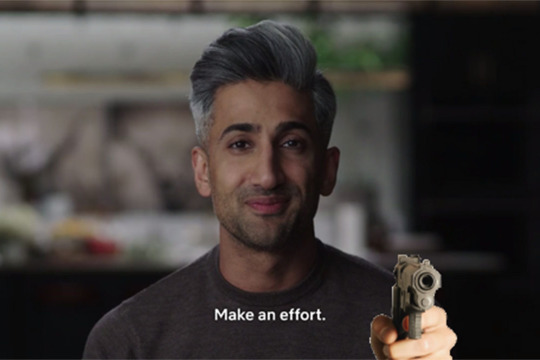
98 notes
·
View notes
Text
Hi okay SO. I have been putting off making an introduction post because I'd mostly prefer people to just look at my blog and decide if they want to hang out based on that, rather than making some big definitive statement about Who I Am.
But I'm currently accumulating followers at a truly alarming rate and - look, I don't want to give the impression I'm ungrateful, I am genuinely SO TOUCHED by every single one of you who's interested in what I have to say!! The feeling is 100% mutual, and I am having a blast sharing everyone's thoughts and enthusiasm. It's just that my goal with this blog is to have fun and do my own thing. I don't hate attention but I'm also not looking for it.
On balance, then, I think it's probably a good idea to give people a general sense of what I'm about so that if it doesn't appeal to you, we can opt out of each other's social circle before anyone steps on anyone else's toes.
My general philosophy:
I am here to have fun. I might occasionally have a little kvetch about some fandom trend or another but ultimately, even if your favourite trope drives me up the wall, I'm genuinely so happy that it is out there bringing you joy. I try very very hard to treat everyone with kindness and to avoid getting caught up in drama.
This isn't a clique it's a community. Please leave commentary on my posts or drop me a message if you wanna chat!
I follow and unfollow pretty liberally and never mean anything personal by it. I might consider you a friend but still unfollow if your current hyperfocus isn't jiving with mine. In turn, I will never take offence to anyone doing the same with me. Regardless of our following status, I'm always up to chat.
I don't do DNIs. Interact if you want to, don't if you don't. Good faith questions and comments are always welcome. Malicious behaviour will be blocked.
Primary Fandoms
Good Omens - I have loved this fandom for years and years, since before the TV show as it exists today was even a twinkle in Neil's eye. I ship Crowley and Aziraphale SO HARD and I am completely blown away by everything that we've gotten since the first season came out in 2019. Fifteen year old me could not even have imagined!!!
Supernatural - Literal opposite energy. I resisted this show for its entire run, after watching the pilot when it aired and thinking "if I watch this, I will end up shipping the brothers, and I am just not prepared for shipping the brothers." Fifteen years later destiel came in swinging with the steel chair and I grumbled and decided I'd better watch it to find out what all the fuss was about. And do you guys know what? I was right all along. I came away from that show obsessed with it as a gothic horror story and shipping the brothers hard. So wincest is my otp, but I'm a multishipper and I have a soft spot for wincestiel, destiel and sastiel too. As a darkfic enjoyer, I also dabble in John/Dean/Sam and variants. I'm not, like, opposed to less-dark takes on this, they just don't do much for me. I'm pretty careful to tag ships in this fandom consistently, so if you don't want to see something, you can blacklist it.
Side Fandoms
You might see these occasionally or for short stretches but they aren't currently taking over my brain the same way Good Omens and Supernatural are.
Ace Attorney (Phoenix Wright/Miles Edgeworth. Queerplatonic Phoenix Wright/Maya Fey. Enthusiastic dabbler in background ships and rarepairs.)
Legend of Zelda: Breath of the Wild+ (Link/Sidon. Link/Gannon. Bemused Link/Zelda ally [I don't ship it but I'm happy for all of you and enjoy the gender bending fanart].)
Ted Lasso (Roy/Keeley/Jamie. Queerplatonic Ted/Rebecca. Rebecca/Sam enjoyer. Pro-finale loyalist. Every single character is my best friend and also my daughter.)
Hannibal (Will/Hannibal. Margot/Alana enjoyer.)
Tagging
I mostly tag for fandoms and ships (although I'm not currently tagging for Crowley/Aziraphale beyond the parent "good omens" tag. That may change if I settle on a tag I like). I wish that I could tag for triggers requested by people who want to follow me, but realistically, that isn't something I can guarantee and trying just wipes me out. If trigger tags are something you need, we may have to admire one another from afar.
At some point I will add a list of useful organisational tags here but for now you can always just browse back through my archives if you're interested.
34 notes
·
View notes
Text
Fashion Style Banners/Moodboards

Rococo
Rococo fashion was worn most commonly in 1700's Europe and continues to be a widely used and praised fashion because of its beautiful themes, clothing, and paintings. A more modern take on this fashion is coquette which became popular from artists like Melanie Martinez and Lana Del Ray respectively. Rococo is most famous for being used in architecture like La Palace de Versailles who housed Marie Antoinette and her husband, King Louis XVI- two other famous figures most known for wearing Rococo clothing and creating the trend in the 1700's.

Dark Academia
This style began in 2015 tumblr and became incredibly popular during the Covid-19 pandemic through social media. Dark Academia takes many inspirations from Victorian and 1910's-40's clothing and the color schemes consist of mostly browns, whites, blacks, and occasional unsaturated colors like green, red, or blue. The style almost looks like one just walked out of a library in an old college. The style is also very common in architecture, which takes many elements from gothic architecture and various historical sights like old churches, libraries, and schools. One of the most famous pieces of media that is used as inspiration in this fashion is Harry Potter- from the uniforms to even the school itself. This fashion is very popular with more realistically artistic people as well as bookworms- obviously.

Scene
This extremely bright and noticeable fashion began in the 2000's from emo fashion and is now one of the most popular alternative styles. This style consists of brightly colored hair that usually covers the forehead or an eye and this style also involves t-shirts with bands or popular media logos on them. Kandi bracelets, poofy skirts or short denim shorts, large belts, and leg warmer are also very popular in this style. Scene music is what began this fashion and the term "Scene Queen" used be a derogatory for attractive, popular women who only like Scene for the aesthetic (also known as "posers") but this term has now become a widely used nickname for anyone in the Scene circle. Scene fell from popular, like Y2k, before becoming more popular in the 2020's through artists like 6arelyhuman and Black Veil Brides.
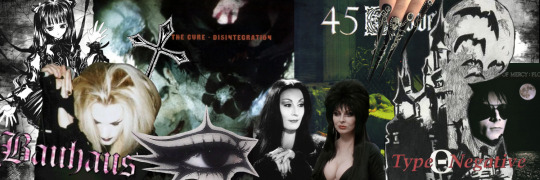
Trad-Goth
Trad-Goth was one of the earliest known versions of goth that is known today as being called "goth". This style was created in the 70's-80's and is most known for it's unique link to music. This style got popular from various goth artists in the 80-90's and has been slowly making a large comeback in the 2020's from it's music. The style itself can be made of almost anything involving black, grey, and white with dramatic and sharp makeup. Most commonly, Trad-Goths wear large belts/corsets, platformed shoes, and Victorian/Punk inspired clothing. Characters in media take many inspirations from this fashion such as Elvira, Morticia Addams, and Dracula (all very loved by the goth community). Many artists have become famous for being involved in this fashion such as Bauhaus, The Sisters of Mercy, and The Cure.
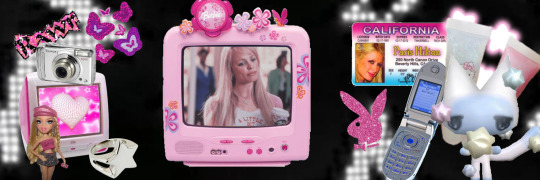
Y2k
Y2K became popular in the 2000's and is most noticeable by it's dramatic makeup, iconic hairstyles, and unique fashion. Y2K consists of concealed or nude lipsticks, blotchy mascara, and thin eyebrows (and the infamous orange foundation).Sparkly tops with rhinestones or sequins, low-rise shorts or jeans, and halter tops. This style was most iconic because of Paris Hilton, Forever-21, and the Bratz doll line by Carter Bryant. Tanning was a very popular part of this fashion because of it's orange undertones and it's supposed "Highlighting of muscles". Bump it hairstyles and highlights/extensions began it's popularity during the 2000's as well. Wearing skirts over jeans and double layer t shirts if not just a tank top was also common. Hoop earrings, large belts, and Ugg's have begun to make a comeback with this fashion in the 2020's, especially 2023.
11 notes
·
View notes
Text
What is dark academia and what does it have to do with social media?
A deep dive into the genre and why it has become so popular.
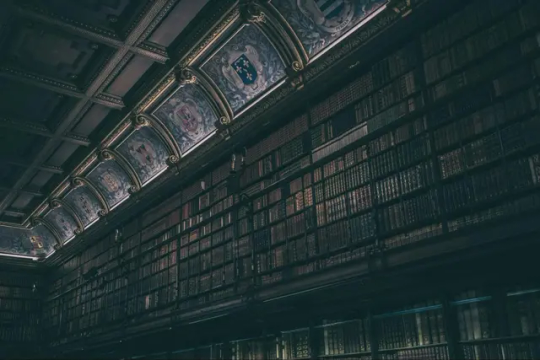
Dark academia has recently been seeing a growth in popularity across social media, with its aesthetic being displayed in movies, television shows, and primarily novels.
The year 2020 marked some significant changes in our media landscape. That may seem like a bit of a nonpoint, but the rise of TikTok coupled with the number of people inside due to pandemic restrictions saw an irreversible change within popular trends and aesthetics.
In the literature community, one such trend was the rise of dark academia. Though the subculture primarily exists online, the term is slowly creeping into the mainstream. In 2022, it was defined by Collins Dictionary as “a social media aesthetic and subculture concerned with higher education, writing and poetry, the arts, and classic Greek and Gothic architecture,” which is somewhat of a broad interpretation. To uncover what makes dark academia such an appealing genre today, one needs to trace back its history; starting with, perhaps most famously, The Secret History by Donna Tartt.
Published in 1992, the novel is what some point to as the first dark academic novel. A pioneer of its time, it is still quite relevant today — it can almost always be counted on to be present on #BookTok recommends tables at bookstores. Set at a fictional college in New England, the novel follows a group of students studying ancient Greek. The narrator, a student who joined the group after its initial formation, unveils how one of them was murdered by the group’s original members. As far as dark academia goes, it’s got it all — murder, Greek aesthetics, a fancy, secluded college. Unsurprisingly, many elements of Tartt’s magnum opus can be found in other books within the genre.
One of the first notable pillars of the genre is right in the name — academia. These novels typically take place in an academic setting; whether this is at a private boarding school or around a college campus. Still, dark academia wouldn’t exactly be academia without some form of academics. Typically, these characters are often studying Ancient Greek, Shakespearean theatre, or English literature — fields that are, for lack of a better word, pretentious. These topics are absolutely for everyone but are not necessarily accessible things to learn about and interact with, or make a living out of. This does not necessarily mean that if a character is studying one of these topics the novel they are in is a dark academic novel, but a character’s field of study, such as these examples, will often add to the atmosphere of dark academia.
A significant number of these stories see characters marked by tragedy, mystery, or both at the same time. Whether that involves crime (see If We Were Villains by M.L. Rio) or a mystery to solve (see Truly, Devious by Maureen Johnson), the characters are typically caught up in a problem larger than themselves, like solving a murder (or, in the case of The Secret History, getting away with one).
Some authors have utilized the genre and its traits to call out and criticize these academic settings which have been historically open only to white and rich individuals, see Babel by R.F. Kuang.
The novel is set in 1828 in Britain and follows Chinese-born Robin who is forced to give his help to an institution that will only use his work to further their goals of colonization. At school, he and members of his friend group continuously face racism as students of colour. Although Robin is a member of this school community, it is clear that many do not want him there, and he, like many of the other students of colour, are viewed as disposable.
As Lenore Sell puts it in her article Beyond the Aesthetics: An Introduction to Dark Academia, “Some of the novels blame elitist structures at educational institutions for the ensuing destruction, or even a dysfunctional academic landscape as a whole, although this connection is not always the object of overt criticism or satire.”
For example, in The Picture of Dorian Gray by Oscar Wilde, the characters are not directly opposed to their wealth, but Wilde uses them and their lifestyles to highlight the inherent lack of morality present in these structures. This novel is an interesting case as it holds elements of magical realism and gothic literature as well as dark academia, but its traits allow it to somewhat fit into both genres.
As more dark academic books continue to be published, their popularity seems to grow. However, sometimes what its readers are chasing is more of a feeling or an aesthetic than quality literature.
Dark academia is directly linked to an old-fashioned kind of style, with modern technology rarely, if ever, appearing in many of its most famous works. The fashion choices of the characters—such as blazers, woolen sweaters, tweed patterns, and just generally darker colour palettes—all contribute to the finely curated aesthetic of dark rooms, classic novels, candles, and typewriters. Sure, these things are all technically dark academia-inspired, but they do nothing more than just scratch the surface of what the genre purports to actually be about: learning, higher education, and literature.
A genre based purely on its aesthetics and vibes might at first seem to be only superficial and provide no substance. It can, however, encompass an idea or way of life that some crave. Sell writes in her article, “The rise of dark academia can be an expression of the longing of younger generations for a lifestyle temporarily or permanently inaccessible to them.”
This longing could especially be felt by those who are unable to afford post-secondary education, or those typically excluded from higher academic circles. Attending a post-secondary institution comes with a sense of community, particularly for those who live on campus and broaden their experiences by participating in new activities and meeting new friends. These institutions, while being flawed, are incredibly important because of this, as they provide something that many of us want. Following this logic, it’s possible then, that the boom in dark academia’s popularity was a result of people longing for these institutions that were closed during the pandemic or are unavailable to so many people.
Racism and class inequality contribute to the lack of diversity seen in higher academic settings, particularly because of how expensive post-secondary education can be. It’s why turning to social media to fulfill these dreams is easier for many.
Katie Xu (@katiexsocials), a TikToker who posts about building your personal brand and learning how to market yourself, posted a video on TikTok’s ability to foster human connections, stating, “People on TikTok are connecting to people. When I see someone on my For You page, I listen to what they have to say … I’m listening to them as a person, and I’m trying to understand them as a person.”
While she does not make any reference to dark academia, her idea has merit because of the way platforms like TikTok are designed to make sure you interact with people who share the same interests as you. Social media itself is perhaps the largest and most influential community there is, so for individuals to turn to that at times of uncertainty and find solace in a niche like dark academia is reflective of the weight the genre held then and still holds today.
Currently, TikTok has over four hundred thousand posts under its dark academia tag, based on videos about the aesthetic and the books that fall into its category. While the majority of the hype (at least in my opinion) has died down a bit, it is still a genre that is very much relevant outside of social media. For example, outside of the literature community, other mediums have used the dark academic aesthetic to tell stories, such as podcasts like The Alexandria Archives or The Magnus Archives. The aesthetic is also present in TV shows like Wednesday or A Series of Unfortunate Events. It can even branch out into music with a more recent example being Taylor Swift’s THE TORTURED POETS DEPARTMENT.
But to bring it back to literature, one of the most recent books on the scene is Curious Tides, by French-Canadian author Pascale Lacelle.
The novel has all the most familiar trappings of a dark academic book, but with a magical twist in line with stories in the fantasy genre. Set at a fictional college, the protagonist has to investigate the secret society that seems to be connected to her classmates’ mysterious deaths. Only, these deaths of which she is the only survivor have left her with heightened powers. Similar to Babel, this blend of a different genre with dark academia prolongs the genre’s lifespan and takes it to places it has not traditionally been.
Like all other trends, the dark academia one will most likely not have wide-ranging impacts outside of its small niches, but I’m talking purely about its aesthetic sense. In the literary market, it looks like there are still plenty more stories to tell that can deviate from the traditional dark academia novel while still using its most popular elements.
#dark academia#the secret history#babel rf kuang#the picture of dorian gray#gothic literature#aesthetic#class inequality#feature story
5 notes
·
View notes
Note
Oh whoa just saw your other socials, you’re reading Echo!! Sorry you’re having a seemingly middling experience with it lol (I will admit that heights/mountain climbing/deep crevices are deep fears of Mine so that might have coloured how terrifying I personally thought the Maudit scenes were when I read it it) but you at least seem to be having a somewhat entertaining time with it, which I still consider at least a semi-win. Super interested to see what your thoughts are (if any) when you’re done!
I'm mostly having a fun, confusing experience!
Like, one chapter is just kinda silly to me, when we go ALL IN on dreading the Alps outside Geneva as if they're actual Mountains of Madness, and not, you know, of Yodeling. Then I cringe at the protagonist ruminating on trust funds fucking up the youths of today. And then yet another chapter brings this sorta self-contained, perfectly executed, thematically interesting detour into the backstory about fires, overgrown roads, and sexual awakenings. And that one is genuinely great. The book is a bit of a rollercoaster is what I'm trying to say, but I'm kinda along for this ride so far.
And the thing is, I kinda understand what the author is getting at, I'm just not sure if he achieves it. Which is to say, he's allegedly playing with gothic tropes of yore (see chapter titles), while actually trying to write a contemporary A24 horror movie in prose form. And that doesn't always work out. Like, say, all those mountains? I can easily imagine a long establishing shot of just that, set maybe to an ominous drone from Mica Levi, and that may very well fill me with dread. I just don't think the written words on paper do that.
To illustrate, there's a, from what I gather, way less high-minded horror movie coming soon which does exactly that with ominous peaks looming over Hunter Schafer:
youtube
And I think it does the trick! The peaks are peaking, the contrast between Modernist Ordnung and untamed nature around it is chilling, and it's kind of a well-worn visual trope in movies, but to try and write the same atmosphere on paper may lead one to some unforeseen purple prose. Or simply a not very effective chapter. What looks great doesn't always read great, and vice versa, just ask Stephen King.
Something about Echo's pace seems way more indebted to current film trends than horror classics. (And I'm not even sure those long shots and excruciating silences work 100% of the time in movies.) Like, I read it and I don't imagine Lovecraft or Jackson's worlds, I see a festival indie horror shot on Arri Alexa in 2018. The prologue is giving exactly that, for one. And something about that doesn't sit right with me. Maybe I want a book, not a detailed movie synopsis. Even if it's a good movie. I dunno.
(I'm bullshitting my way through this answer, I don't know if you can tell.)
Or, look, maybe I simply don't love so called elevated horror and its glacial pace. (Mountaineering puns not intended.) But I'm at least curious about this whole thing, and the fire chapter is Good Actually (and cinematic in a great way), so on we read.
Thanks for the recommendation!
3 notes
·
View notes
Note

hi hi ! how r you doing? ^_^ do you have any fashion aesthetics that you enjoy? :]
Hello! Yes, so many! I enjoy a lot of JFashion, particularly lolita (& it's many subtypes. I mostly like EGL & sweet lolita. I enjoy ouji too & it's more "mature", aristocratic variations, but the boyishness of ouji is so charming), and jirai kei and mori kei and jojifuku as of late... I also love Victorian fashion, and Rococo, and... general American fashion trends from the early to mid 2000s (enjoy the scene/scemo era quite a bit), and Gothic & Punk fashion from the source, although there's so many subtypes of those, as well. I really enjoy watching 80s movies and seeing their fashion, too, the things people wore every day rather than the exaggerated neon costumes people sell at Halloween stores. I also don't necessarily always enjoy it, but I like to look back on trends from the mid 2010s, such as 2013 fashion in particular. Why? Well, due to not only a sense of nostalgia, but the fact I love to imagine Max Caulfield wearing things of the period, like a big owl pendant. I had something similar. I used to love owls. It is still cute to me, sometimes. Sorry, I got out of hand. I like historic & traditional fashion from all over the world, though. It's interesting for me, to read books on the subject. When I was still in Paraguay I read a book that spoke about so much, even indigenous fashion of the Guarani, & it was nice. I enjoy a lot of specific designers for runways & such, too, but I'll keep it simple for you and say that if you need this for any little project, you can just keep in mind the styles I listed earlier, since that's more in line with "aesthetics" rather than general things I like.
Thank you for the cute little picture. I have done worse. I hope you're doing nicely. Today I opened the curtains in my bedroom to try to feel something.
4 notes
·
View notes
Text
Daily update: I got some real sleep last night! Which is to say I woke up in the middle of the night but was actually able to fall back asleep for a few more hours. Real sleep seems to be a game changer and I’m hoping I can trend in a more positive direction. Just took dose 4 of paxlovid so I think that might be working, too. The sore throat continues to suck but I let myself have some Tylenol today and I’m hoping that takes care of it.
One thing I’m noticing is that I have limited endurance for verbal communication right now and it drains me much more than it usually does. (Probably a sign that I shouldn’t be typing this tumblr post, but ah well.) I don’t know if that’s autism or ADHD related. I think it might be? Also help, my job involves so much verbal communication. Somehow I’m going to have to find a way to “ease back into it” while also “catching up” with what I missed. I’m really worried I’ll be forced to exert myself during the recovery period, and I could use some good strategies around setting work boundaries.
Today’s Small Selfish Topic I Will Let Myself Talk About Because I Am Sick And It Sucks To Be Sick, So I Get To Be Self-Aggrandizing For One Post A Day:
People on my dash are talking about Pride and Prejudice inspired YR fic plots, and Sara in Lydia Bennet situations. And people on my dash are also talking a lot about Bridgerton.
And it’s making me think about Heart and Homeland and how proud I am of the writing I did for that. I wrote Sara into a Lydia-and-Wickham inspired plot in Heart and Homeland, mixed up with a bit of Jane Eyre and Vanity Fair and such. Wilhelm does sort of play a Darcy role to Sara and August, but things play out differently than they do in P & P, just because it felt fun to change up the formulas and let people react to things differently. And one of the ways it’s different than P & P, I guess, is that we go inside Sara’s head in a way we don’t get to go inside of Lydia’s, and understand what’s going on with her and why she does what she does. Maybe that’s the Jane Eyre influence—Jane Eyre tells her whole story in first person after all—but anyway. I’m just. Very proud of what I did there. And very proud of the comeuppance I gave August in the end. (Lest you suspect I’m too soft on August, I did give him quite a tragic comeuppance with a side of gothic horror to it. So. Facts about me I guess.)
And very eager to continue writing the epilogue of the fic, which has been interrupted by too many life events. So if my normal level of verbal skills could come back it would just. Be nice. Thanks.
2 notes
·
View notes